belt Oldsmobile Intrigue 2002 s Owner's Guide
[x] Cancel search | Manufacturer: OLDSMOBILE, Model Year: 2002, Model line: Intrigue, Model: Oldsmobile Intrigue 2002Pages: 363, PDF Size: 2.53 MB
Page 35 of 363
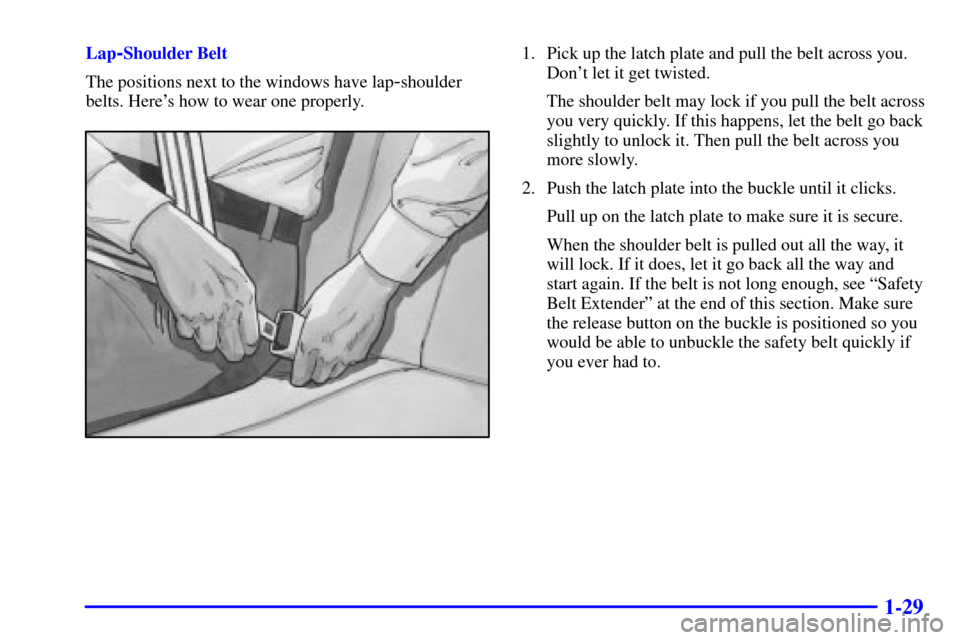
1-29
Lap-Shoulder Belt
The positions next to the windows have lap
-shoulder
belts. Here's how to wear one properly.
1. Pick up the latch plate and pull the belt across you.
Don't let it get twisted.
The shoulder belt may lock if you pull the belt across
you very quickly. If this happens, let the belt go back
slightly to unlock it. Then pull the belt across you
more slowly.
2. Push the latch plate into the buckle until it clicks.
Pull up on the latch plate to make sure it is secure.
When the shoulder belt is pulled out all the way, it
will lock. If it does, let it go back all the way and
start again. If the belt is not long enough, see ªSafety
Belt Extenderº at the end of this section. Make sure
the release button on the buckle is positioned so you
would be able to unbuckle the safety belt quickly if
you ever had to.
Page 36 of 363

1-30
3. To make the lap part tight, pull down on the buckle
end of the belt as you pull up on the shoulder part.The lap part of the belt should be worn low and snug on
the hips, just touching the thighs. In a crash, this applies
force to the strong pelvic bones. And you'd be less likely
to slide under the lap belt. If you slid under it, the belt
would apply force at your abdomen. This could cause
serious or even fatal injuries. The shoulder belt should go
over the shoulder and across the chest. These parts of the
body are best able to take belt restraining forces.
The safety belt locks if there's a sudden stop or a crash,
or if you pull the belt very quickly out of the retractor.
Page 37 of 363

1-31
CAUTION:
You can be seriously hurt if your shoulder belt is
too loose. In a crash, you would move forward
too much, which could increase injury. The
shoulder belt should fit against your body.
To unlatch the belt, just push the button on the buckle.
Page 38 of 363

1-32
Rear Safety Belt Comfort Guides for
Children and Small Adults
Rear shoulder belt comfort guides will provide added
safety belt comfort for older children who have
outgrown booster seats and for small adults. When
installed on a shoulder belt, the comfort guide better
positions the belt away from the neck and head.
There is one guide for each outside passenger position in
the rear seat. To provide added safety belt comfort for
children who have outgrown child restraints and for
smaller adults, the comfort guides may be installed on
the shoulder belts. Here's how to install a comfort guide
and use the safety belt:
1. Pull the elastic cord out from between the edge of
the seatback and the interior body to remove the
guide from its storage clip.
Page 39 of 363

1-33
2. Slide the guide under and past the belt. The elastic
cord must be under the belt. Then, place the guide
over the belt, and insert the two edges of the belt into
the slots of the guide.3. Be sure that the belt is not twisted and it lies flat.
The elastic cord must be under the belt and the guide
on top.
Page 40 of 363

1-34
4. Buckle, position and release the safety belt as
described in ªRear Seat Outside Passenger Positionsº
earlier in this section. Make sure that the shoulder
belt crosses the shoulder.
To remove and store the comfort guides, squeeze the
belt edges together so that you can take them out of the
guides. Pull the guide upward to expose its storage clip,
and then slide the guide onto the clip. Turn the guide
and clip inward and place them in between the seatback
and the interior body, leaving only the loop of elastic
cord exposed.
Center Passenger Position
Page 41 of 363
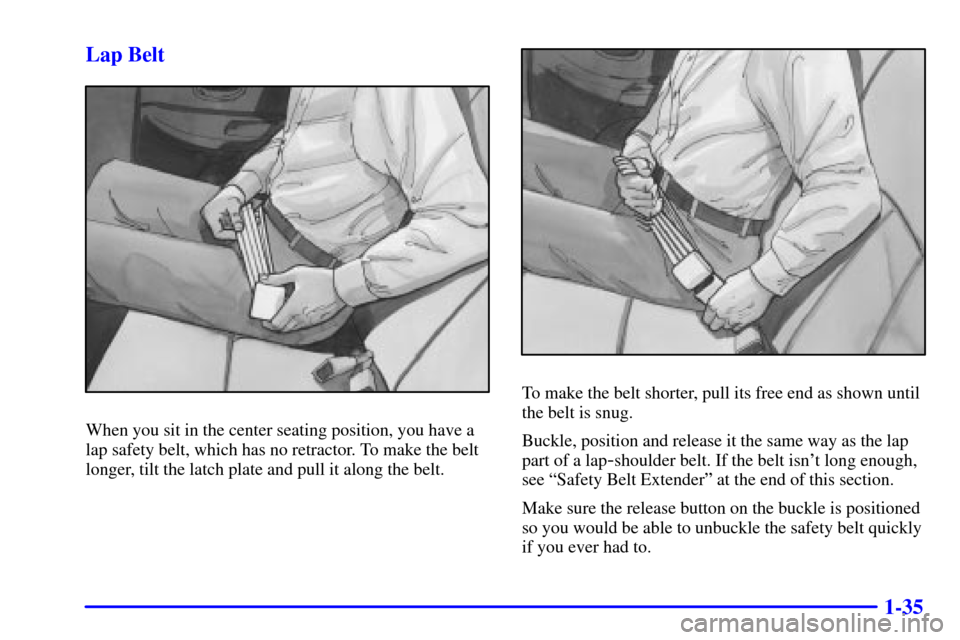
1-35 Lap Belt
When you sit in the center seating position, you have a
lap safety belt, which has no retractor. To make the belt
longer, tilt the latch plate and pull it along the belt.
To make the belt shorter, pull its free end as shown until
the belt is snug.
Buckle, position and release it the same way as the lap
part of a lap
-shoulder belt. If the belt isn't long enough,
see ªSafety Belt Extenderº at the end of this section.
Make sure the release button on the buckle is positioned
so you would be able to unbuckle the safety belt quickly
if you ever had to.
Page 42 of 363
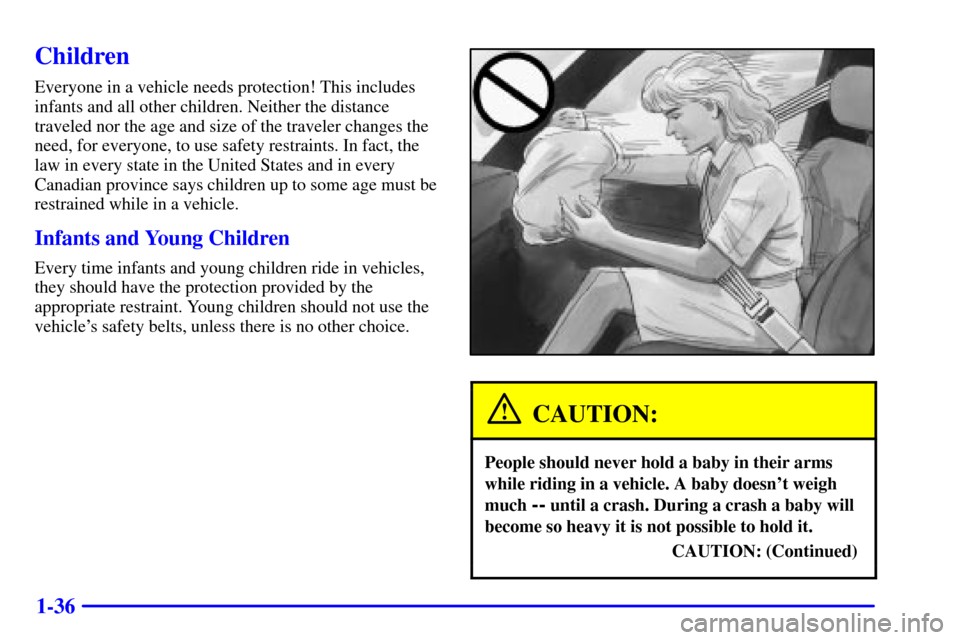
1-36
Children
Everyone in a vehicle needs protection! This includes
infants and all other children. Neither the distance
traveled nor the age and size of the traveler changes the
need, for everyone, to use safety restraints. In fact, the
law in every state in the United States and in every
Canadian province says children up to some age must be
restrained while in a vehicle.
Infants and Young Children
Every time infants and young children ride in vehicles,
they should have the protection provided by the
appropriate restraint. Young children should not use the
vehicle's safety belts, unless there is no other choice.
CAUTION:
People should never hold a baby in their arms
while riding in a vehicle. A baby doesn't weigh
much
-- until a crash. During a crash a baby will
become so heavy it is not possible to hold it.
CAUTION: (Continued)
Page 43 of 363
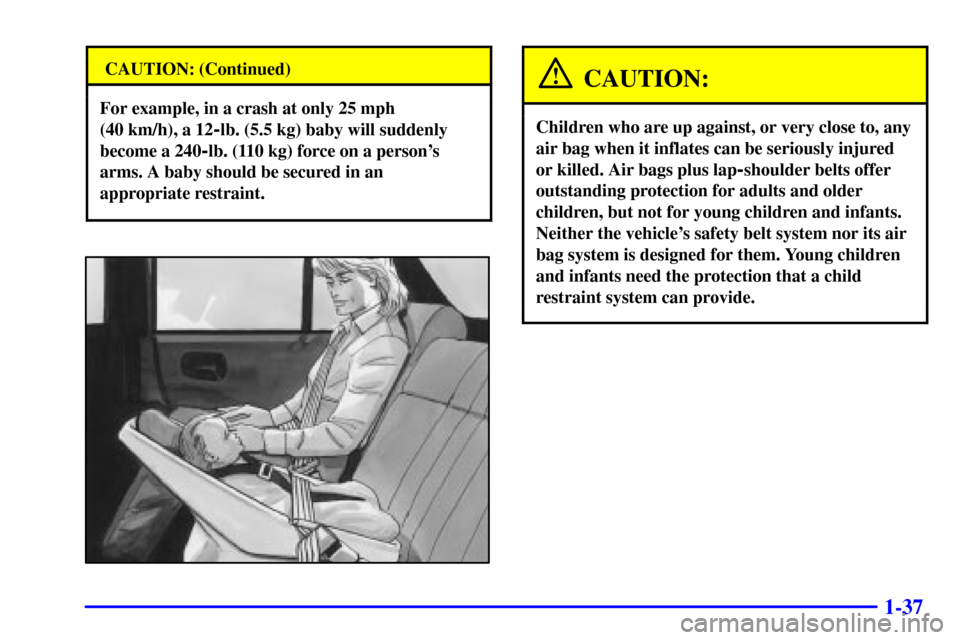
1-37
CAUTION: (Continued)
For example, in a crash at only 25 mph
(40 km/h), a 12
-lb. (5.5 kg) baby will suddenly
become a 240
-lb. (110 kg) force on a person's
arms. A baby should be secured in an
appropriate restraint.
CAUTION:
Children who are up against, or very close to, any
air bag when it inflates can be seriously injured
or killed. Air bags plus lap
-shoulder belts offer
outstanding protection for adults and older
children, but not for young children and infants.
Neither the vehicle's safety belt system nor its air
bag system is designed for them. Young children
and infants need the protection that a child
restraint system can provide.
Page 45 of 363
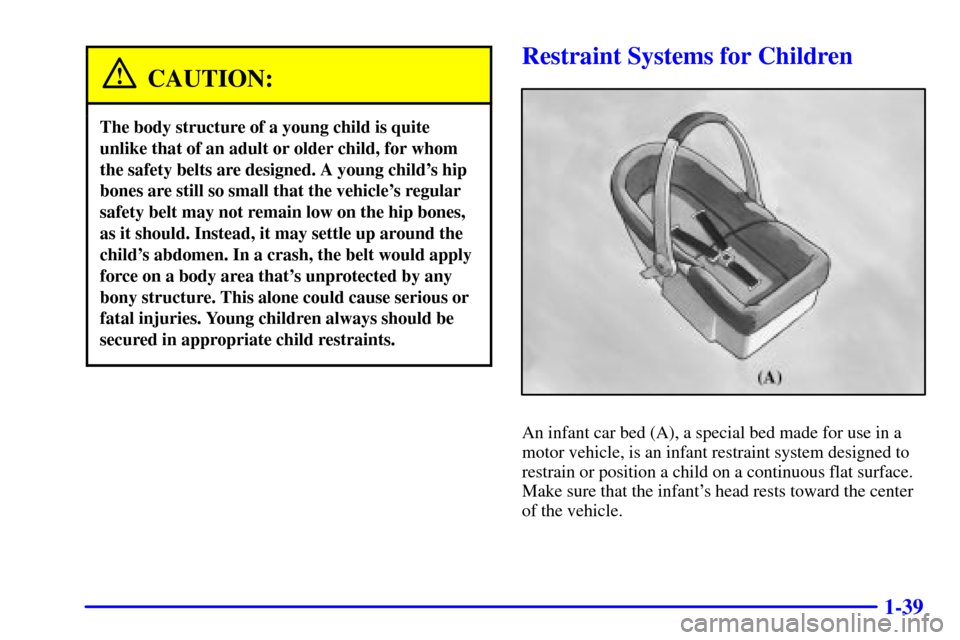
1-39
CAUTION:
The body structure of a young child is quite
unlike that of an adult or older child, for whom
the safety belts are designed. A young child's hip
bones are still so small that the vehicle's regular
safety belt may not remain low on the hip bones,
as it should. Instead, it may settle up around the
child's abdomen. In a crash, the belt would apply
force on a body area that's unprotected by any
bony structure. This alone could cause serious or
fatal injuries. Young children always should be
secured in appropriate child restraints.
Restraint Systems for Children
An infant car bed (A), a special bed made for use in a
motor vehicle, is an infant restraint system designed to
restrain or position a child on a continuous flat surface.
Make sure that the infant's head rests toward the center
of the vehicle.